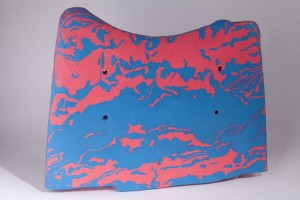The boggie board is broken, it is now more proportionate to the human body, in fact it could be a torso.
‘Could be a torso’? ‘Like’ a torso?
Connotating a torso?
Why not just a piece of detritus, a former useful leisure object? Something simply to dispose of in landfill (being non-recyclable)?
The human body has been against this piece of rubberised foam, imprinted itself, sublimated itself to the function of this object. Its history is inseparable from the body, its reason for being was in the service of the human body. The body is documented in this artifact, its presence is undeniable and ineffable.
The piece of boogie board becomes something else, its resemblance to its original form is displaced, denaturalized. The natural signification is broken, the expected link is opened out, dispersed into a noise of alternatives (interference).
The signifier floats as it is cast into the sea, cast into a heavy metal; at once beguilling and undermined, the signifier multiplies. This space in-between signifiers and possible signifieds where meaning breaks open, induces a perpetual de ja vous for all those meanings that are inconclusive, unresolved. The matter of life that is inexplicable, uneasy in its unknown, the points where we consciously (I must not get sidetracked, bogged down) move on so as to not stop to see our limitations, our lacks, our stupidities, our isolation. Yet the breaks are precisely the moments when we let the possibilities in, stopping to be affected, to allow our self to be contested and pierced.
How to escape the demon of analogy? By ‘feigning a spectacularly flat respect (this is the Copy, which is rescued)’.[1]
The broken piece of boogie board copied in bronze seems metonymically indexed to its referent, yet this is the illusion of doxa, the literal signification, the denotation produced by the connotation. Rather it is the metalangauge embodied in its ‘brokeness’, where the metonym is extended into the ‘third meaning’ into signifiance where its connotations become the reverberations of the unnatural floating signifier.
This copy undermines its metonymical meaning for its signification has little to do with a boogie board (the referent), and subsequently a feigned indexical relationship, and more to do with a break in our perception of experience of a material object and our subjective substitution with this object. In other words, the referent is replaced with the self (one’s self) and our limitations and imitations in the construction of our identity; the broken fragment is a palimpsest for our unknowingness and the absence of the body.
[1] Roland Barthes, Roland Barthes (Berkeley: University of California Press, 1994), 44.
Broken, bronze, acrylic paint, 2011



